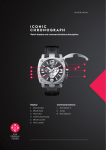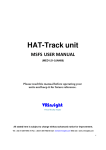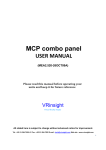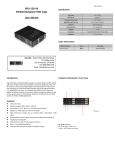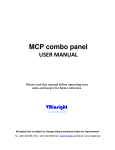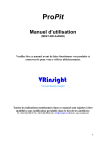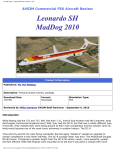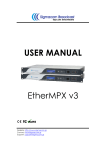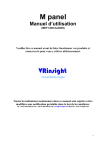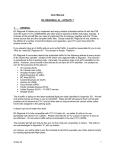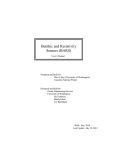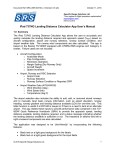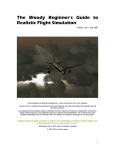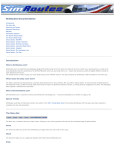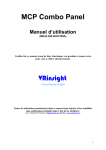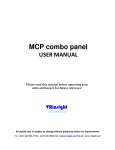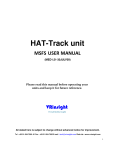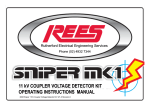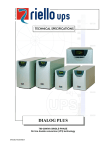Download MCP combo panel - Amazon Web Services
Transcript
MCP combo panel USER MANUAL (MEA2 520-5JAN09) (MEA2.520-5JAN09) Please read this manual before operating your units and keep it for future reference. VRinsight Virtual Reality Insight Virtual Reality Insight All stated here is subject to change without advanced notice for improvement. Tel : +82-31-284-7090~91 Fax : +82-31-284-7092 E-mail : [email protected] Web site : www.vrinsight.com 1 BEFORE USE : Thanks for purchasing VRi’s MCP Combo panel. Before operating your units, please read through this manual and keep it for future reference. For any further question, visit VRi’s web-site (www.vrinsight.com) or contact as below; Tel : +082-31-284-7090 (7091) Fax : +082-31-284-7092 E-mail (Support team) : [email protected] NOTE : This manual could be redistributed unless you modify the contents. This manual has been written out on a Serial FP v2/Jet Liner’s MCP combo panel basis. All software (& software versions) stated here (MEA2.520-5JAN09) is subject to change without advanced notice for improvement. improvement If you want to download the latest driver version for panel & application programs, visit www.vrinsight.com Box contents 2 VRinsight MCP combo panel The MCP combo panel of VRinsight features various types of aircrafts’ panel with full control complement ; default aircrafts of MSFS, most freeware and commercial add-on add on aircraft (Wilco’s (Wilco s B737 Classic, Classic PMDG PMDG’s s B737NG & 744, 744 Level-D’s Level D s B767B767 300 and PSS’ A319,320,330,340). It is completely interfaced with MSFS9 and MSFSX through add-on software *SerialFP2” which enables MCP combo panel to perform full simulation with simple connection your computer through USB. Package including universal power supply adaptor (DC 5V). The MCP combo panel is comprised of EFIS, MCP & COM (Instrument Radio) part to understand advanced flight p g controls for beginners g and less advanced users starting flight simulation games at a first step. Each control part; EFIS, MCP & COM has push buttons, rotary knobs, toggle S/Ws and/or 2 line character type LCDs offers actual flight circumstance with full control complement. •SerialFP2 software supports all functions to MCP combo panel • MCP combo panel consumes high power. To avoid malfunction , do not use many other USB interfacing devices. We recommend using external power supply (DC 5V adaptor) • If you want to use a USB hub, be sure that the USB hub must compliant with USB 2.0 standard. Otherwise it may cause a malfunction. 3 EFIS part MCP part COM part The MCP combo panel features the following controls: EFIS part : - Toggle S/Ws for VOR1,2/ADF1,2 . - Knob S/Ws for MINS, BARO, CTR ; ND mode selector and TFC. - Push buttons for FPV, MTR, WXR, NAVAID, WPT, ARPT, DATA - All buttons and rotary knobs are user-programmable MCP part : - 2 line character type LCD displaying SPD, HDG, ALT and Pitch & Bank at Autopilot p Status - On/Off toggle S/Ws for F/D, A/T - Thrust mode selection buttons: N1, SPD, FLCH - Push buttons for HDG SEL & HOLD, ALT HOLD, V/S SEL, TOGA, CRZ, VNAV, LNAV, CMDA, CMDB, CMDC, LOC, CWSA(Y/D), CWSB(BCRS), APP - On/Off toggle switch for DISENGAGE. COM(Instrument Radio) and 8-User programmable control part : - 2 line character type LCD displaying COM & NAVAID Frequencies, DME distance, speed, VOR ID & CRS, Squawk code - 5 push buttons for Instrument radio function selector (COM, NAV, ADF, DME, TRANSPONDER) - Rotary knob for NAVAID’s frequency change, CRS/OBS, Squawk Code - TFR button for activating stand-by frequency - 8 User programmable control buttons 4 Features • Integrated unit with full radio stack function : EFIS part, MCP part, COM part • All necessary buttons, switches and LCD panel to input SPD, VOR, HDG and all other functions for getting close to real flight. • Offer actual flight circumstance via MCP combo panel with full control complement • Full metal cases • One year warranty Technical specifications • USB interface type to computer • External power requirement : DC 5V adaptor or USB power supply type to MCP combo panel. We recommend using DC 5V adaptor. • 50cm(W) x 14cm(H) • 4Kg Compatibility software • Flight simulator 2004 / FSX by Microsoft Operating software • SerialFP2 5 SerialFP2 Installation With MCP combo b panel, l an “I “Install t ll DVD” iis iincluded. l d d Wh When you iinsertt it iin DVD d driver i of your computer, “VRinsight HTML” document will be shown. Then click “SerialFP2” (operating software) and install it at a proper folder. “SerialFP2” is the main operating software of VRinsight used for all VRinsight flight panels. SerialFP2 software supports full functions of MCP combo panel and completely interfaced with MSFS9 and MSFSX enables full simulation with simple connection with your computer through USB. Be sure that when installing SerialFP2, “Install USB-Serial Driver” must be checked. After installation, you can find “SeiralFP2” in “All programs” of “Start menu”. USB Connection The connection between MCP combo panel and your computer is made using a USB cable that plugs into an USB port on your computer. If you want to use a USB hub, be sure that the USB hub must compliant with USB 2.0 standard. Otherwise it may cause a malfunction. When you connect MCP combo panel to your computer at first, your computer will detect it and will describe the process step by step. Power Connection Power supplying of MCP combo panel is done by universal power supply adaptor DC 5V (Included in package) and/or USB port of your computer. Make sure that before trying to operate MCP combo panel, you must confirm the USB connection first in order to prevent malfunction. Before trying to operate, be sure that LCD displaying is shown. Run “SerialFP2” When you confirm all setup processes done; “SerialFP2” installation, “USB connection” and d “P “Power connection”, ti ” you are ready d tto operate t MCP combo b panel.l Download & install “FSUIPC” Refer to “Download & install FSUIPC” at “Download” part of www.vrinsight.com 6 Double click shortcut of “SerialFP2” or find it in “All programs” of “Start menu . If e everything e yt g is s do done ep properly, ope y, be below o window do will be sshown. o Run MSFS9 / MSFSX and run SerialFP2. Drop down “Select Aircraft” to select aircrafts and press “Load FS Module” button. * Before operate MCP combo panel, check “Re-Try”. 7 EFIS part controls explanation EFIS (Electronic Flight Instrument System) : It is used to control the respective Primary Flight Display (PFD) and Navigation Display (ND). EFIS panel includes controls for selecting various modes and ranges on the ND as well as switches to display NAVAIDS, waypoint, airports and etc. Two toggle S/Ws allow displaying of the left and right VOR and ADF bearing pointer on the ND. Controls are available to set barometric altimeter settings for displaying on the PFD. •The functions of each button and knob can be differed from the explanation according to the aircraft's aircraft s implementation implementation. Also, Also buttons and knobs are user programmable for another functionality. 8 L or R VOR / ADF switch : Select NAVAID between VOR or ADF. Toggle S/W MIN S Pushing : Resets or blanks PFD display Rotating : Adjusts PFD radio or baro minimums altitude BAR O Pushing : Displays preselected barometric setting Rotating : Adjusts barometric reference CTR Pushing : Displays full compass rose for APP, VOR and MAP modes. Subsequent pushing alternates between expanded and centered displays Rotating : Changes ND(Navigation Display) mode among APP, VOR, MAP, PLN. APP : Approach mode, displays ILS, localizer and glide slop information in heading up format. Reference ILS receiver ILS frequency or identification receiver, identification, course and DME Rotate & Push VOR : VOR mode, displays VOR navigation information in heading up format. Reference VOR receiver, VOR frequency or identification, course and DME and TO/FROM information MAP : Map mode, displays FMC-generated route and map information airplane position, position heading and track in tracking-up format. Displays waypoints, including the active waypoint within the selected range. Also displays VNAV deviation PLN : Plan mode, displays a stationary true north-up route depiction. Route may be reviewed selecting “STEP” at using the CDU legs TFC Pushing : Displays TCAS information on the ND Rotating : Selects the desired ND nautical miles range scale 9 FPV MTRS Displays p y flight g p path vectors on PFD Displays PFD altitude meters indications MAP buttons : Selects or removes ND information. More than one displayed may be selected at a time WXR Displays weather radar information STA Displays high and low altitude navigation aids in the 10, 20 or 40 NM range and high altitude navigation aids only if range is selected above 40 NM WPT Displays waypoints if range selector is set to 10, 20 or 40 NM ARPT Di l Displays airports i t iinformation f ti ; ID ID, di distance t and d etc t DATA Displays the FMC estimated time of arrival and altitude at each waypoint Push SW POS TERR Displays ADIRU and both GPS positions and VOR raw data radials extended from the nose of the airplane to the stations. Displays the Enhanced Ground Proximity Warning System terrain data on the ND. The data is mutually exclusive of WXR data, so selecting one deselects the other. priorities are : Between WXR and TERR the p •Terrain warning • Predictive wind shear warning • Terrain caution • PWS caution 10 MCP part controls explanation MCP (Mode Control Panel) : It provides control of the Autopilot Autopilot, Flight Director, Director Altitude alert and Auto-throttle System. The MCP is used to select and activate Autopilot Flight Director System, (AFDS) modes and establish altitudes, speeds and climb/descent profiles. 11 A/T Toggles gg Auto-Throttle Mode On/Off F/D Activates or Deactivate Flight Director(F/D) The commands bar on the PFD annunciated when activated. DISEN GAGE CRS Controls autopilot engagement Rotating : Decides the course (OBS) to NAVAID(VOR) SPD Rotating : Decides the speed of airplane to fly HDG Rotating : Decides the heading of airplane to fly ALT Rotating : Decides the altitude of airplane to fly V/S Rotating : Decides the vertical speed of airplane to fly 12 TOGA CRZ N1 SPD In takeoff / go-around / Cruise : Generates certain t torque with ith A/T is i On. O FLCH Changes the flight level to the altitude indicated on LCD p y on PFD p pitch flight g mode annunciator as p pitch Displayed mode and auto-throttle automatically engaged. HDG SEL HDG HLD Autopilot heading mode: Heading Select(HDG SEL), Heading Hold (HDG HLD) HDG SEL sets heading on LCD, PFD and ND HDG HLD holds heading established at wings level. ALT HLD Engages Altitude as a pitch mode and displays it PFD pitch flight mode annuniciator. AFDS commands pitch to maintain Altitude VNAV Takes over and controls the pitch and airspeed in accordance with ith a pre-sett profile(If fil (If VNAV and d Auto-throttle A t th ttl armed). d) VNAV engages above 400 feet radio altitude LVNA CMDA LOC Makes airplane tracking Magenta line on the ND. LNAV engages if airplane is above 50 feet radio altitude, within 2.5 NM of active leg, and within path capture parameters of ground, intercept angle and bank angle, to active leg. CMDB CMDC Engages A/P (A, E (A B, B C is i th the number b off /AP and is different on the type of airplane) Engages Localizer and AFDS as roll mode to capture and track inbound on front course 13 V/S FPA APP Y/D BCRS Engages g g vertical speed p or flight g p path angle g as p pitch mode Engages Localizer as roll mode and glide slop as pitch mode AFDS captures and tracks localizer in LOC mode and capture glide slop in glide slop mode. Localizer captures when intercept track angle is within 120 degrees of localizer course. Glide slop captures when intercept track angle is within 80 degrees of localizer course. Yaw Damper Back-Course Mode LCD display : It shows SPD, HDG, ALT, V/S and Autopilot Status or Aircrafts attitude (Pitch & Bank) 14 COM part controls explanation COM (Instrument Radio) Panel & 8-User Programmable Buttons : It provides id radios di stack t k ffunction ti and d user programmable bl control t lb buttons. tt 15 Selection buttons : Buttons are used to carry out a pre-defined f function ti that th t has h been b assigned i d tto it b by th the currentt menu GEAR UP GEAR OFF GEAR DN FLAP UP FLAP DN A.BRK RTO A.BRK DEC A.BRK INC 8 User programmable control buttons according to the aircraft. Above definitions are the example when it’s used with Level-D 767-300ER. COM NAV ADF DME TRN Select one of 5 Radio Panel functions. Swap COM/NAV’s standby to Active frequency AUX AUX button. Rotate to select COM/NAV/ADF frequency, frequency Squawk Pushes to change the digit LCD display : It shows the information of COM1 &2, NAV1 & 2, ADF, DME, TRNANSPONDER(SQUAWK CODE) Converts power source USB : Supplied the power from USB port Neutral : Power off EXT : Supplied the power from external power supplier (DC 5V adaptor) 16 Preparing MCP combo panel before flight Check installation “SerialFP2”. Step 1 : Initial check up As USB cable is plugged into your computer, initial messages are displayed on LCD screen. MCP combo panel has 2-line character type LCD to display various flight data and control information. NOTE : Please check the Serial No & Version. All software(& software version) stated here are subject to change without advanced notice for improvement. Please verify the latest version for panel via www.vrinsight.com Initial message of MCP part Initial message of COM part Initial message of MCP combo panel panel, firmware version is showed up up. LCD blinking is normal. LCD is blinking from time to time until the panel is linked to application software and flight simulator. 17 Step 2 : Run flight simulator (MSFS9 / MSFSX) 1) Run flight simulator (MSFS9 / MSFSX) before linking USB connected panel to application software “SerialFP2”. 2) Select flight. Step 3 : Run panel linking application software “SerialFP2”. Run application software “SerialFP2” which linking MCP combo panel to flight simulator. Be sure that flight simulator is already started. When you run “SerialFP2”, below window will be shown. 1 2 3 4 5 7 6 8 1 : Number of COM(USB) port 2 : Type of panel 3 : Fi Firm ware version i 4 : Aircraft selection 5 : Link to game 6 : Software loading sequence change Original sequence (MSFS loading first => SerialFP2 running) New sequence (MSFS loading / SerialFP2 running first => SerialFP2 running / MSFS loading) 7 : Input test for panel 8 : Link test for panel with game 18 Drop down “Select Aircraft” and press “Load FS Module”. As connection success, LCD display will be also changed as follows. After connection message of MCP part After connection message of COM part Above pictures showing the display on MCP combo panel after successful linking. Basically It displays SPD, HDG, ALT and aircraft’s attitude; bank and pitch on upper and lower line of “----“. MCP combo panel supports various aircrafts (MSFS’s original aircrafts and other payware aircrafts such as Wilco, Wilco PMDG, PMDG Level-D & PSS) PSS). All of buttons on the panel are user programmable. Use key-mapping software provided; “SPF2_MCP_KeyMapper” for MCP-Combo panel. After an aircraft selected, press “Load FS Module” button. 19 Key-command sticker key-command sticker is provided with product and enclosed DVD has “KeyCap_Decal.pdf” file for “LETTERING” based on MSFS9 / MSFSX . Please print it out and use for your purpose. Payware aircrafts. MCP combo panel supports various type of aircrafts including default aircraft of MSFS, freeware and payware. payware Supported payware aircrafts are; MSFS Original Aircraft Level-D B763-SP3(FS9) Level-D B763-SP2a(FSX) PMDG-B737/747(FS9) PMDG-B737 Only(FS9) PMDG-B737/747-FS2Crew(FS9) PMDG-B744(FSX) Wilco B737 PIC Wilco 777ER Wilco airbus ½ (2D) Wilco airbus ½ (3D) Wilco A380 v2 Wilco embraer-ERJ Wilco embraer-Legacy Wilco Cessna Citation X PSS A319/320(FS9) PSS A330/340(FS9) Cooksky Super 80 pro F1 ATR-72 All of controls on the panel, push buttons and rotary encoders, are programmable using key-mapping software. Any aircrafts can be supported, if key-commands are known at least and added on “SerialFP2” software’s aircraft list. PMDG-737NG/744 PMDG controls aircrafts using key-commands. Many controls are missing in pre-defined key-commands. Fully defined command files are provided in enclosed DVD. Apply These files before flight with PMDG’s 737NG and 744 aircraft. To work correctly with provided definition file and the MCP combo panel, service pack and update patch must be applied; SP1 and update patch 1.3 for PMDG-737NG and update 1.x for PMDG-744. Installing Key-Command Definition file ((1)) PMDG’s key-command y files are exist at …\Flight g Simulator 9\PMDG. It’s 737Kbd.ini for PMDG-737NG and 747400Kbd.ini for PMDG-744. Replace these files with provided. (2) If only PMDG-737NG aircraft is installed, Find key-command definition file named “737Kbd.ini” at \Aircraft support\PMDG_ B737NG_747400\Installed_737_only\ and copy to …\Flight Simulator 9\PMDG\. 20 (3) If PMDG-737NG/744 are installed, Find two key-command definition file named “737Kbd.ini” and “747400Kbd.ini” at \ \Aircraft f support\PMDG_B737NG_747400\ \ G G \ and copy to …\Flight \ S Simulator 9 \PMDG\. (4) Confirm key-commands are loaded correctly. Follow MSFS menu, PMDG -> General->Keyboard Commands and examine the definitions. Be sure that all commands are defined to Key Combination without blank. Find matched panel drawing with newly defined key-commands at \Doc\SerialFP2_ MCP_Setting_PMDG.pdf. Now you are ready to fly PMDG’s aircraft with MCP combo panel. MCP combo panel application to PMDG’s (1) Confirm “FSUIPC” and KeyMapper files are installed before running MSFS9. (2) Follow MCP combo panel running procedure (Panel checking Æ Running MSFS9 Æ Running SerialFP2) (3) Default key-map definitions for PMDG are below. 21 Push to MTR 2 . DEC Altimeter 3 . ALT STD 1 . INC Altimeter Push to FPS ... 1 .UP to F / D On 2 /ADF 2 2 DEC STA WPT CTR FPS ARPT DATA TFC MTR JetLiner POS TERR ADF 2 VOR 2 BARO ’ s MCP 2/ F/ D F A/ T TOGA T 1 CRS SPD FLCH MCP Push to ... SEL HDG - LCD D HLD ((FL ) 3 . Push to (FL ) 2 . DEC Altitude HLD ALT VNAV APP LOC LNAV Push to A /P C CWSB CWSB CMDB COM NAV TRANSPONDER ADF RADIO O DME 1/ 2 Select ADF 1 / 2 Select NAV 1/ 2 Select COM 1/ 2 Select DISENGAGE CMDC Push to CMDB ... / P CMDA Push to Push to A / P APP On / Off / P LOC On / Off Push to A Push to A A /P ENGAGE CWS SA CMD DA 1 . Up to A / P Engage 2 . Down to A / P Disengage /P CWSA FPA V/ S Push to A 2 DEC . V . Speed (x 100 ) 3 . Push to AV .NA Panel Push too L . NAV Push to V 737 / 744 1 . INC V . Speed (x100 ) 1 .INC Altitude Push to ALT HOLD Push to HDG HOLD Push to HDG SEL N1 SPD 2 .DEC Heading 3 . Push to (>100 ) ( <999 ) Push to THR FLCH Push too THR SPD Push to THR N 3 . Push to 1 . INC Course / OBS 2 . DEC Course / OBS 3 . Push to 1 .INC Speed 2 . DEC Speed : PMDG G 1 . INC Heading Type DME - LCD TRN < - X -> MODE Pussh to TFR Pow wer Src . Select ( USB / Off/ Ext ) 5 . TRN : SB 3 Mode - C ( NORM / STBY ) 4 . DME : 3 . ADF : 1 . COM : 2 . NAV : Push to Radio View Push to THR View Push to OH View Push to FMC View Push to LOC View Push to APP View Push to Zoom View Push to Mail View * To ru un SerialFP v2/MCP P properly at PMDG G 737NG, set up 60 00/700/800/900 files and update patch hes. KeyM Mapper re-definitio on can be done using SPF2_MCP_KeyMapper.exe. Push to TERR Push to POS Pussh to DATA Push to APR RT Push to WPT WX W ADF 1 VOR 1 MINS ... SerialFP v ... Push to Push to P to A / T Engage 1 .UP 2 . Down to A / T Disengage 2 . Down too F / D Off (BARO ) (BARO ) Push to STA Push to WX 1 . Up to INC VOR 2 . Down to VOR 2 . CCR to DEC ND range 3 . Push to ND TFC 1 . CR to INC ND range 3 . Push to ND CTR 1 . CR to INC ND mode 2 . CCR to DEC ND mode 1 . Up to INC VOR 1/ ADF 1 2 . Down to DEC VOR 1/ ADF 1 3 . Push to 1 . INC MINS 2 . DEC MINS 22 Level-D 767-300ER Level-D provides SDK S (S f (Software Development Kit)) for f 767-300ER aircrafts. f External add-on software or hardware can access Level-D’s controls directly instead of keycommand. This SDK is great for developers. Interfacing DLL module which is developed with Level-D’s SDK is provided for MCP combo panel. The DLL module is developed with SP3 of Level-D 767-300ER. Be sure this patch, SP3 is applied. Find matched panel drawing with interfacing module at \Doc\SerialFP2_MCP_Setting_LVLD_763.pdf. N Now you are ready d tto fl fly L Level-D’s l D’ greatest t t aircraft i ft with ith MCP combo b panel.l MCP combo panel application to Level-D’s (1) All service packs (SP3) must be installed before running MSFS9 2004. (2) Follow MCP combo panel running procedure (Panel checkingÆ Running MSFS9 2004 Æ Running SerialFP2). (3) Enjoy your flight flight. Basic functions of panel are below below. 23 Push to (BARO ) (LEFT ) to VOR (LEFT ) to ADF ... _ DH _DH ... ( Right ) to VOR ( Right ) to ADF FPS ... ... TFC MTR JetLiner POS TERR ADF 2 VOR 2 BARO 1 CRS Push to THR FLCH Push tto THR SPD Push to TH HR N F/D F A /T TOGA ... Push to N1 ... FLCH Push to ALT HOLD SEL HDG HLD ALT Push to VS Button HLD ( FL ) (FL ) Y/ D On / Off APP LOC LNAV / P LOC On A / P Left COM TRANSPONDER ADF RADIIO NAV DME 1/ 2 Select ADF 1/ 2 Select ILS & VOR / DME (L / R ) COM 1/ 2 Select B /C On / Off DISENGAGE CWSB A/ P Right A /P Center / Off / Off Push to A / P APP On Push to A Panel A / P ENGAGE CMDC CMDB CW WSA CM MDA 2. Down to A / P Disengage 1. Up to A / P Engage FPA V/ S VNAV .NAV Push tto L . NAV Push to V - D 767 - 30 00 1 . Increase V . Speed (x100 ) 2 . Decrease V . Speed 3 . Push to ... MCP - LCD D 3. Push to 1. Increase Altitudee 2. Decrease Altitude Push to HDG HOLD ... SPD SPD 2 . Decrease Heading 3 . Push to HDLSEL 1 . Increase Heading : LEVEL DME - LCD TRN < -X -> MODE *K KeyMapper re-de efinition can be d done using \bin\SPF2_MCP_Key yMapper.exe. Capt / FO Panel Swap 2/ 3 . Push ... 1 OBS 1 OBS 3 . Push to 1 . Increase AP SPD 2 . Decrease AP SPD Ty ype 1 . Increase NAV 2 . Decrease NAV V ’ s MCP SerialFP v Push to Push to WPT ARPT DATA CTR GA Switch EHIS RTE DATA STA ADF 1 VOR 1 MINS WX W EHIS APRT EHIS WPT EHIS NAVAID EHIS INOP 1 . RMI knob 2 . RMI knob 2 . Decrease ND Range 3 . Push ND Range Button 1 . Increase ND Range 3 . Push ... 2 . Decrease ND Mode 1 . Increase ND Mode 1 . RMI knob 2 . RMI knob 3 . Push to (BARO ) 1 . INC Altimeter ... 1 . A / T Arm ( Up ) 2 . A / T Disarm (Down ) 1 . F/ D Onn (Up ) 2 . F/D Offf (Down ) 2 . DEC Altimeter 3 . ALT STD Push to 1 . Increase ADI 2 . Decrease ADI 24 ... ... Puush to TFR Poower Src ... ... ... ... ... . Select (USB / Off / Ext ) 5 . TRN : SB 3 Mode - C (NORM / STBY ) 3 . ADF : 4 . DME : 1 . COM : 2 . NAV : ... Push to Push to Push to Push to Push to Push to Push to Puush to 3-3. PSS-A330 PSS’s A330 aircraft is controlled by key-command similar to PMDG’s. Defect to PSS’s aircraft command definition is “fast rotation”,i.e. SPD, HDG, ALT etc, are missing. Response to incoming command from the panel is very slow. Newly defined keycommand file is provided and find matched panel drawing at \Doc\ SerialFP2_MCP_Setting_PSS_A330.pdf. PSS A-330 aircraft’s configuration file where key-commands are defined exists at …\Flight Simulator 9\Pss\Airbus A3XX\. Copy provided new configuration file Aircraft support\PSS_A3XX\ t\PSS A3XX\ config330.pnl fi 330 l to t …\Flight \Fli ht Si Simulator l t 9\P 9\Pss\Airbus \Ai b A3XX\ A3XX\. Now you are ready to fly PSS A-330 aircraft with MCP combo panel. 25 4. Radio panel MCP combo panel is incorporated with MCP, EFIS and radio panel. Radio panel used for all aircrafts features frequency input (COM / NAV / ADF), information display (VOR / DME) and Squawk code input to Transponder. After converting DME screen, input OBS1, OBS2 value with rotary switch. - COM1,COM2 : Inputs p ATC and communication frequency. q y - NAV1, NAV2 : Inputs frequency of radio navigation facility (VOR, ILS/DME). - ADF : Inputs ADF frequency. - DME : Displays frequency information of radio navigation facility (VOR,ILS/DME) inputted by NAV1, NAV2. Also displays ID, distance & deviant speed (from radio navigation facility) and approaching speed (to radio navigation facility). - TRN : Inputs Squawk code. Radio panel has selection buttons (COM/NAV/ADF/DME/TRN). TFR button for activating stand-by frequency. Rotary-key for changing digit. 26 MODE RADIO-LCD RADIO LCD <-X-> COM NAV ADF DME 1. COM: 2. NAV: 3. ADF: 4. DME: 5. TRN: SB3 Mode-C (NORM/STBY) TRN Power Src. Select (USB/Off/Ext) Push to TFR COM1/2 Select ILS & VOR/DME(L/R) ADF 1/2 Select DME 1/2 Select TRANSPONDER As pushing each function button, LCD displays various information Rotating rotary switch changes stand-by frequency (or squawk code). Pushing rotary switch changes a digit. TFR switch(< - X - >) activates current stand-by frequency (or squawk code). DME just displays information of radio navigation facility tuned to navigation. With SquawkBox3 of VATSIM, TRNsponder offers “MODE-C NORM/STBY” conversion function. Power source select switch : Convert switch when you change power source 27 Trouble shooting O /O ON/OFF trouble - USB S port and power supply. MCP combo panel is high power consuming device. Connect the panel to USB port on your computer directly. When it works incorrectly, using external power supplying AC-toDC adaptor is recommended. Adaptor 5V, 1A If DC power adaptor is used, be sure power switch position to EXT. INITIAL LCD DISPLAY trouble - Link test. After connection, check the initial messages (MCP & COM part). If no message shown, confirm whether you have checked “Install USB Serial Driver” of “SerialFP2” setup wizard. If SerailFP2 can not find COM port for CDU, check Device Manager whether CDU has been assigned or not. Aft checking, After h ki lilinkage k still till d does nott work. k Th Then use other th USB ports. t S Some USB portt is dummy port. Initial LCD display MCP part COM part 28 LCD BRIGHTNESS trouble - LCD contrast When the panel is plug into your computer, initial messages are displayed on LCD after power-on selftest. If it’s dimmed or cloudy, tune the contrast. Tune LCD brightness dark bright PANEL FUNCTION trouble 1 - Panel function test When MCP combo panel is linked to “SerialFP2” software correctly, control linkage and functioning of the panel can be tested without starting flight simulator. (1) Check the check box. (2) P Press b buttons tt or rotate t t rotaryt encoder of your MCP combo panel. Commands are transferred to your computer and result will be displayed on software. Some transferred values, i.e. SPD, HDG, and ALT, are identical to displayed on LCD LCD. 29 PANEL FUNCTION trouble 2- FSUIPC check Download & install FSUIPC is required for MCP combo panel use with Microsoft’s Flight Simulator. If you didn’t download & install, do it now. Basic function of FSUIPC is enough to operate. No registration is required. Also check “FSUIPC.dll” file is in “\Program Files\Microsoft Games\Flight Simulator9 \Modules”. Further information, see “download & install FSUIPC” part. PANEL FUNCTION trouble 3 – Procedure check 1) Run MSFS first 2) Download & install FSUIPC 3) Setup “SerialFP2” 4) Connect MCP panel to PC 5) Run “SerialFP2” 6) Check “Re-Try” is checked 7) Select your aircraft 30































